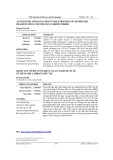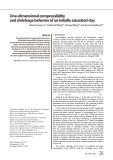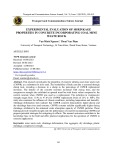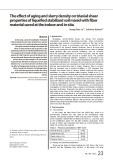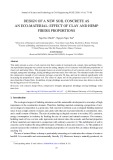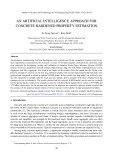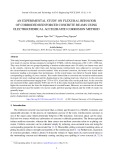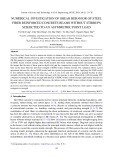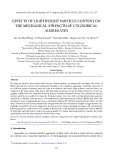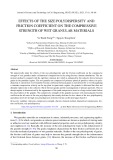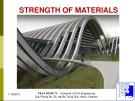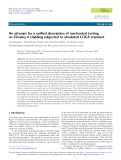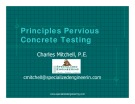
Compression test
-
In this paper, the effect of continuous carbon fibers (CCF) on the stiffness of 3D printed frames is investigated. Fused deposition modelling (FDM) technology is employed to build three typical frames with 15% of CCF and 85% poliamide 12 which is combined 10% short carbon fibers (PA12-CF) for compress testing.
 7p
7p  viengfa
viengfa
 28-10-2024
28-10-2024
 0
0
 0
0
 Download
Download
-
This paper presents the experimental study on onedimensional compressibility behavior, soil water characteristic and soil shrinkage behavior of slurry Amberger kaolin. The volume change behavior of sample due to the suction and that due to applied vertical stress demonstrated a similarity within the saturation domain.
 4p
4p  vibecca
vibecca
 01-10-2024
01-10-2024
 0
0
 0
0
 Download
Download
-
This research investigates the properties of concrete utilizing coal mine waste rock (CMWR) as a substitute for river sand. The workability of fresh concrete is assessed through slump tests, revealing a decrease in a slump as the percentage of CMWR replacement increases.
 13p
13p  vibecca
vibecca
 01-10-2024
01-10-2024
 0
0
 0
0
 Download
Download
-
In this study, a series of Consolidated–Undrained triaxial compression tests were conducted at a constant axial strain rate, with a small unloading and reloading during the monotonic loading to investigate the effect of various densities and curing times on the mechanical properties of Liquefied Stabilized Soil (LSS).
 6p
6p  vibecca
vibecca
 01-10-2024
01-10-2024
 0
0
 0
0
 Download
Download
-
This study presents a series of soil concrete mix that is made of excavated soils, cement, lime and hemp fibers. An experimental program was carried out on the testing samples of soil concrete with different proportions of clayey soil and hemp fibers.
 12p
12p  vifilm
vifilm
 24-09-2024
24-09-2024
 1
1
 1
1
 Download
Download
-
In this study, a supervised learning ANFIS model was developed to predict the compressive strength of concrete at 28 days. Data used in training and testing model were collected from a previous study.
 13p
13p  vifilm
vifilm
 24-09-2024
24-09-2024
 5
5
 1
1
 Download
Download
-
This study investigated experimental bearing capacity of corroded reinforced concrete beams. Six testing beams were made of concrete having compressive strength of 25 MPa, with the dimensions of 80 x 120 x 1200 mm. They were divided into two groups depending of tension reinforcement ratio.
 11p
11p  viyoko
viyoko
 24-09-2024
24-09-2024
 3
3
 1
1
 Download
Download
-
In the present study, from recent experimental results of asymmetrical loading tests on SFRC beams without stirrups, three NLFE models have been validated and further developed to evaluate the impact that the ratio of shear span-to-depth (a/d) and the compressive strength of steel fiber concrete (SFC) have on the shear behavior and shear strength of SFRC beams without stirrups.
 15p
15p  vifaye
vifaye
 20-09-2024
20-09-2024
 5
5
 1
1
 Download
Download
-
By using an extensive three-dimensional discrete element method, we numerically investigate the effects of lightweight particle content on the mechanical strength of the cylindrical aggregates, randomly composed of two different groups of primary particles: light (low stiffness) and heavy (high stiffness), and the stress contribution of the heavy-heavy, light-heavy, and light-light interactions on the mechanical behavior of such aggregates, subjected to the compression test by using a constant downward velocity.
 11p
11p  vifaye
vifaye
 20-09-2024
20-09-2024
 2
2
 1
1
 Download
Download
-
We numerically study the effects of the size polydispersity and the friction coefficient on the compressive strength of wet granules under a diametrical compression test by using discrete element simulations. The numerical method is coupled with the capillary cohesion law which is enhanced by the cohesive forces between grains in the pendular regime.
 9p
9p  vifaye
vifaye
 20-09-2024
20-09-2024
 1
1
 1
1
 Download
Download
-
Chapter 3 - Axially loaded members. The following will be discussed in this chapter: Normal stress and normal strain, tension and compression test, poisson’s ratio, shearing strain, allowable stress – factor of safety, statically indeterminate problem.
 43p
43p  larachdumlanat122
larachdumlanat122
 28-11-2020
28-11-2020
 30
30
 1
1
 Download
Download
-
The present study is an attempt to provide a unified description of the failure not directly depending on the tested geometry. This effort aims at providing a better understanding of the link between several existing safety criteria relying on very different mechanical testing.
 9p
9p  christabelhuynh
christabelhuynh
 30-05-2020
30-05-2020
 9
9
 0
0
 Download
Download
-
Principles Pervious Principles Pervious Concrete Testing present of Test Methods for Previous Concrete; ASTMASTM C1688/C1688MC1688/C1688M – 10a10a; ASTMASTM C1701/C1701MC1701/C1701M – 0909; ACI 522R-10; Compressive Strength of Pervious Concrete; ASTM draft – Compressive Strength Procedure – Curing Cylinders;...
 68p
68p  pjflexri
pjflexri
 10-03-2015
10-03-2015
 49
49
 4
4
 Download
Download
-
Phép đo sức bền cơ nhiệt TMCT (Thermal Mechanical Compression Test) được ứng dụng để đo nhiệt độ hóa mềm Tg-r (glass-rubber transition temperature) của bột gạo ở khoảng ẩm độ thấp từ 2.4-19.5 % cơ sở ướt. Kết quả cho thấy Tg-r tăng khi ẩm độ giảm. Nhiệt độ hóa mềm của gạo đo bằng phép đo sức bền cơ nhiệt tương tự với các kết quả được trình bày trong các nghiên cứu khác sử dụng các phương pháp nhiệt lượng kế quét vi sai DSC (Differential Scanning Calorimetry), phân tích cơ nhiệt (TMA-Thermo-mechanical Analysis) và phân tích cơ nhiệt động (DMTA-Dynamic Mechanical Thermal...
 12p
12p  hoa_bachhop
hoa_bachhop
 07-03-2012
07-03-2012
 83
83
 14
14
 Download
Download
-
Nếu đưa ra một kiểu Document, và ta cũng không biết là lớp này có hỗ trợ giao diện IStorable hay ICompressible hoặc cả hai. Ta có thể có đoạn chương trình sau: Document doc = new Document(“Test Document”); IStorable isDoc = (IStorable) doc; isDoc.Read(); ICompressible icDoc = (ICompressible) doc; icDoc.Compress();
 5p
5p  phuoctam39
phuoctam39
 13-07-2011
13-07-2011
 52
52
 5
5
 Download
Download
-
Withholding further diagnostic testing and anticoagulant treatment in those patients with an unlikely clinical probability and a normal D-dimer level, which constitutes 30–50% of all referred patients, is safe. The remaining patients need to undergo (repeated) compression ultrasonography. An alternative approach is to perform a whole-leg imaging test on the day of referral. The advantage of this approach is that it eliminates the need for a repeat test (and may even obviate the probability assessment and D-dimer testing).
 5p
5p  thanhongan
thanhongan
 07-12-2010
07-12-2010
 66
66
 3
3
 Download
Download
-
A typical geotechnical engineering project begins with a site investigation of soil and bedrock on and below an area of interest to determine their engineering properties including how they will interact with, on or in a proposed construction. Examining of soil properties, especially in shear stress, is indispensable to understanding of the area in or on which the construction will take place. There are two main kinds of the test: direct shear test and triaxial test.
 9p
9p  hoangly
hoangly
 24-06-2009
24-06-2009
 154
154
 25
25
 Download
Download
CHỦ ĐỀ BẠN MUỐN TÌM








